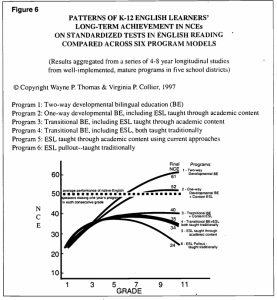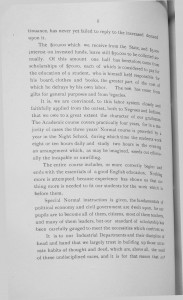According to Thomas and Collier’s interpretation of Berliner & Biddle’s 1995 article on English language education, “In 1988, 70 percent of U.S. school-age children were of Euro- American, non-Hispanic background. But by the year 2020, U.S. demographic projections predict that at least 50 percent of school-age children will be of non-Euro-American background.” (Thomas, Collier 13). These percentages indicate that non-English speaking populations are growing rapidly. So rapidly in fact, it will be very important in the coming years to figure out how to give these students the best chance for success in the American school system. Reformers are faced with the task of how to approach the education of these non-English speaking students.
Over the past two decades English language learning has evolved tremendously. It has become a necessity to educate American citizens in a Multilingual fashion due to the influx of immigrants and non-English speaking U.S. citizens. Many American teachers don’t know exactly how to approach the education of these citizens. There are a multitude of programs that educate non-English speaking students. Two-way bilingual programs, developmental bilingual programs and transitional programs are all educational agendas that focus on literacy in two languages. These bi-literal agendas have come to be known as Dual Language Programs. According to The Massachuettes Association for Bilingual Education, “Dual language is a form of bilingual education in which students are taught literacy and content in two languages.” (MABE). In comparison, English as a second language (ESL) programs and Structured English Immersion (SEI) programs are more geared toward proficiency in English only (NCELA). The two types of programs differ in that English only programs do not encourage and sometimes do not allow the use of Spanish and other non-English languages. English only programs which are highly in use in American schools are criticized for putting non-English speaking students at a disadvantage in terms of academic success beyond the understanding of English. As educators search for better ways to help their non-English speaking students achieve academic success they have run into a wall of debate surrounding the issues of Dual Language versus Single Language education. How have some educators of Spanish-speaking students attempted to shift to dual-language learning programs since the 1990s, and what kinds of challenges have they faced?
The early 1990s was a time period of slight criticism of the bilingual learning plan. As America underwent a transformation of its population and continues to undergo this transformation conservative voters have come out of the woodwork in groves with a “keep America American” type of mentality. Unfortunately while this attitude can be seen as patriotic it also does a good job of stigmatizing millions of English learning students. Laws like Proposition 227 have made it hard for certain states to continues their bilingual education programs despite the proven effectiveness of the programs. Dual Language learning programs which have proven effective for both English speaking and non-English speaking students are not taken seriously. In recent years educators of non-English speaking students have tried to push for more Bilingual programs across the country because they are equally beneficial for both types of students.
According to Smith and Rodriguez, in 1965 “Bilingual Education was made a public policy in the US with the Elementary and Secondary Education Act (ESEA). (Smith and Rodriguez)” Since that time, the perception of this act and the ways in which it is carried out have shifted. According to Smith and Rodriguez, “The 2001 reauthorization of ESEA brought with it vast changes in how language minority children are educated in the US.” (Smith and Rodriguez). According to the ESEA any student whose original language is not English is now classified as “English Language Learners” (Smith and Rodriguez). These English language learners have two types of learning options. English Only education separates the language minority students and teaches proficiency in English Only and after a certain period of time these students are migrated into the regular population to continue their schooling. Dual Language uses both languages equally. Dual learning has been put onto a pedestal recently as it seems like an effective way to garner the attention of these language deficient students.
While Dual Language learning seems great, there are deeper factors that must be analyzed. The Sociolinguistic Environment of a Bilingual School by Kathy Escamilla is a 1994 case study that reports about a California school with a population of about 1200 students and a focus on Bilingual Education. The study concentrates on how an effective Dual Language program must have an environment outside of class where both languages are of equal importance. The data that Escamilla provides indicates the emphasis of English over Spanish in the classroom settings. (Escamilla)
According to Escamilla, “English is the language used to give students awards and rewards and English is the language used between adults, even adult bilinguals. All of the above impresses upon students that the important language is English and that Spanish serves no purpose other than as a “bridge to English”. (Escamilla 41). Escamilla follows this by noting that, “No matter what teachers and other people in the school “tell” students about the importance of being bilingual what they do in the context of both the classroom and the larger school environment presents a contradictory and much stronger message.” (Escamilla 42).
Escamilla’s findings indicate that while Dual Language education is a great goal it has minor discrepancies that limit its potential. For instance, educators in Dual Language classes do not emphasize the importance of the native languages of their students, which turns the native language into a translation tool as opposed to a cultural benefit. When utilizing Bilingual education, educators have to be weary about focusing too much on one language while downplaying the significance of the other language.
Reformers of the 1990s were worried about giving too much instruction in English therefore not fulfilling their goals of Spanish literacy. On the other hand there were similar worries that by incorporating Spanish instruction, the students would not be able to complete the main goal, which was to learn English. Some of the findings in Escamilla’s case study may have been crucial in the passing of Proposition 227 in 1997.
Proposition 227 banned bilingual education in California. Active at the beginning of the following school year, it became illegal to teach children in any other language that wasn’t English. Massachusetts and Arizona followed in California’s footsteps and by 2002 they were the only 3 states to completely ban bilingual education.
According to Susan Eaton’s 2012 report, in 2002, Massachusetts, California and Arizona were the only 3 states to have completely banned bilingual education (Eaton 2). By law, these states forced educators to use Structured English Immersion (SEI) plans in which non-English speaking students were separated from their English-speaking peers. In the segregated classrooms non-English speaking students were taught specifically in English until they showed enough improvement to return to the normal population.
While these laws are still in place in the 3 states, there has been a growing concern over the need to provide students with the alternative for Bilingual education. According to Eaton, “policymakers see it not only as an effective educational method, but also as a dynamic model of ethnic and cultural integration in a rapidly changing society” (Eaton 3).
Following Prop 227 some California schools converted into Charter Schools in order to continue using their dual-immersion programs. “Under California law, charter schools are exempt from virtually all state rules.” (Schnailberg). Other California school districts use a 1974 Supreme Court ruling which helped Chinese students take non-English classes (Alorro). Despite these few states banding against Dual Language education, research has shown that the benefits for students are uncanny.
School Effective for Language Minority Students by Wayne P. Thomas and Virginia Collier is a report published in 1997 that focuses on K-12 data for language minority students. The study uses over 700,000 “language minority” student records from between 1982 and 1996. (Thomas, Collier 31). This study cites long-term findings of non-English speaking students in order to see how they well they did up until their final years of regular education. The research uses these long-term results in order to compare the benefits of two-way bilingual classes with English only classes. According to their research, “children in well-implemented one-way and two-way bilingual classes outperform their counterparts being schooled in well-implemented monolingual classes, as they reach the upper grades of elementary school.” (Thomas, Collier 15). This finding is significant because it ultimately shows the effectiveness in dual language programs in preparing student for academic success. Their research also cites the importance in building “sociocultural context” for English language learners. Similar to Escamilla’s findings, when both languages are of equal importance it is beneficial to students of a non-familiar language backgrounds.
In their study, Thomas and Collier ask the question, “”Which characteristics of well-implemented programs result in higher long-term achievement for the most at-risk and high-need student?” (Thomas, Collier 26). They found that Dual Language programs have a great effect on the students academic record. The graph below shows how students of non-English speaking backgrounds need to work twice as hard to catch up with the regular population once their are out of the ESL classes.

Some of the most important findings of this study were the findings on School Effectiveness. The researchers labeled L1 as the students native language and L2 as English. According to Thomas and Collier, “Students born in the U.S., who received 2-3 years of schooling in both LI and L2 in U.S. schools, made greater progress than similar groups who received all of their schooling in English (L2), with ESL support, in U.S. schools.” (Thomas, Collier 50). This data also goes to the fact that Dual Language Programs are beneficial to students.
Thomas and Collier also attest to the fact that students who recieved mixed language work did better overall on their assignments. According to Thomas and Collier, “Students who received L I academic content and L2 academic content (taught by teachers trained in second language acquisition and the content areas who were also socioculturally supportive of students) did better than students who received only L2 academic work.” (Thomas, Collier 51). This finding shows that recieving work in both languages make it easier for the students to succeed. This finding also points to the fact that the students are not intellectually challenge but once they are given the opportunity to learn in their own language it makes it that much easier. Thomas and Collier follow this finding by stating that student groups in their research sample, “who are separated from grade-level classes for most of the school day for several years do not know the level of cognitive and academic work expected in the mainstream, and with time, students may develop lower aspirations for their own academic achievement” (Thomas, Collier 52). This finding goes against the belief that ESL or SEI programs have the same effect on students as Dual Language programs. The following graph from Thomas and Collier’s study shows just how much more effective Dual Language Learning Programs were.

This graph shows that by grade 11, students in Dual Language and billingual programs were much more successful than students in ESL and SEI programs. Thomas and Collier’s research shows us that “the program with the highest long-term academic success is two-way bilingual education” (Thomas, Collier 53).
If Dual Language programs are so effective what are educators doing to get them implemented. Many reformers cite the need for Bilingual education to inspire non-English speaking students to achieve at higher rates. Bilingual education has the ability to help non-English speaking students learn English but it also has the ability to teach English-speaking fluency in another language thus making these students more valuable by preparing them for communication with nations outside of the United States. Educators locally and nationally are making the push to get more dual language programs put into place. In her 2012 Hartford Courant article, Andrea Dyrness states, “the movement to restrict languages in schools is directly connected to the movement to restrict immigration.” (Dyrness). She also points to anti non-English education as a “disservice” to an English speaking students. I think dual language education is important because of the benefits of being multilingual in a competitive national economy. Other educators like Susan Eaton cite the importance of Multilingual education because of its ability to garner friendships and bonds across cultures. Educators are making clear strides at implementing Dual Language programs more widely because of its numerous benefits. While they are faced with few roadblocks such as Prop 227 it seems as if at least a small portion of American schools will be geared toward bilingual education.
Works Cited
Alorro, Audrey. “English-only Law Hits California Schools Ban on Bilingual Education Ignites Protest.” Freedom Socialist Party, October 1998.
“Bilingual Education – Dual Language Programs.” Bilingual Education, n.d. http://www.massmabe.org/Dual-Language-Programs.html.
Dyrness, Andrea. “English-Only Teaching Ignores Bilingual Benefits.” Hartford Courant, March 23, 2012.
Escamilla, Kathy. “The Sociolinguistic Environment of a Billingual School: A Case Study.” Bilingual Research Journal 1&2, no. 18 (Winter/Spring 1994).
Eaton, Susan. “Have We Learned Our Language Lesson?” One Nation Indivisible (June 2012). http://www.onenationindivisible.org/wp-content/uploads/2012/06/ONIstory4LanguageLessonV4.pdf.
NCELA. “Language_Instruction_Educational_Programs.pdf”, n.d. http://www.ncela.gwu.edu/files/uploads/5/Language_Instruction_Educational_Programs.pdf.
Schnaiberg, Lynn. “Some Calif. Schools Finding Ways Around Prop. 227.” Education Week, September 30, 1998. http://www.edweek.org/ew/articles/1998/09/30/04biling.h18.html?qs=two-way_bilingual.
Schnaiberg, Lynn. “Two-Way Bilingual-Ed. Programs Show Promise, New Study Suggests.” Education Week, March 23, 1994. http://www.edweek.org/ew/articles/1994/03/23/26note.h13.html?r=1312758814.
Thomas, Wayne P., and Virginia Collier. School Effectiveness for Language Minority Students. NCBE Resource Collection Series, No. 9. National Clearinghouse for Bilingual Education, George Washington University, Center for the Study of Language and Education, 2011 Eye Street, N.W., Suite 200, Washington, DC 20006. Tel: 202-467-0867., December 1997. http://www.eric.ed.gov/ERICWebPortal/detail?accno=ED436087.





